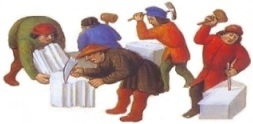
Gothic Design
Learn More.
| HOME Feature Articles Stone Carver's Tour Virtual Cathedral Cathedral Tours Gothic Field Guide GOTHIC GEOMETRY Virtual Abbey Medieval Art Tours Castle Tours Links Resources About The Site FAQ |
|
Chapter I. In Praise of Stonecutters
Standing before the strange beauty of a Gothic cathedral, it's easy to see why writers always wax poetic about the artistry, skill and sacrifice of the medieval stonecutter. Yet despite the heights they achieved, the workaday life of a stone mason most often included haggling over money, complaining about the working conditions, and gossiping about the clergy! They sometimes got along with the other guilds (or not), exhibited varying degrees of talent and were most often well-compensated for their effort - extra if they could carve statues or gargoyles. And from this day-to-day world of chisel hitting stone, professionalism juxtaposed with personal backbiting... the classical architecture of Rome was somehow turned completely on its head. With little if any formal education, the stonecutters brought to the Not So Dark Ages the most creative and original ideas ever known to architecture up to that time. Few masons thought of themselves as artists, of course - although it's certain many knew they were on to something special: i.e., it would be four centuries before Europe erected anything higher than the 466 foot high spire of Strasbourg Cathedral, completed in 1439.
Today, in the post-post-modern world (when we all should know better, supposedly) it is not the height, the grace, nor the artistry, but the most primitive aspects of Gothic that continue to fascinate. Most
innovations were thought up 'on the fly' by stonecutters who picked
up practical tips
and tricks from each other, learning as they went through
stone mad Europe plying the
|
Sponsored
Links
copyright © 2017

 The
politically correct Renaissance era later looked down its nose
at the
The
politically correct Renaissance era later looked down its nose
at the